The second part of our series of 2015-16 Alpine Skiing World Cup season reviews concentrates on men’s speed disciplines.
Svindal Dominates First Half Of Season

Having competed only at the World Championships in the previous season while recovering from an Achilles injury, Aksel Lund Svindal made a strong comeback to the World Cup tour. He won both the downhill and super-G races of the season’s first speed weekend in Lake Louise. Since then he was the man to beat in speed disciplines.
In January he achieved his fourth win in the season’s five downhill races by then when he celebrated his first victory in the classic Lauberhorn downhill in Wengen. A week later in Kitzbühel he achieved his third win in the four super-G races by then. He was the favorite on the following day to finally win the prestigious Hahnenkamm downhill in Kitzbühel. Yet the downhill race turned into a disaster for him. One of the three skiers to crash in poor visibility, Svindal ruptured the ACL of his right knee, ending his season while leading the overall World Cup.
Thanks to his consistently great results in the first half of the season, Svindal remained in contention for the downhill and super-G titles until the final weeks of the season. In downhill he even remained as the leader until Peter Fill overtook him by 26 points in the final race for the title. Also in super-G Svindal’s results were enough to make the World Cup podium as he completed the Norwegian sweep in third place.
Jansrud And Kilde Norway’s Other Speed Stars
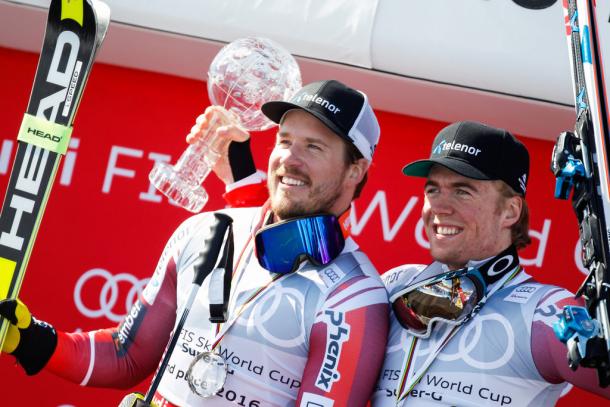
Kjetil Jansrud came into the season as the defending champion in downhill and super-G as well as the runner-up of the previous season’s overall World Cup. This season he couldn’t reach the level of the previous winter; although he achieved one win in each of downhill, super-G, alpine combined, and parallel giant slalom, he lacked the consistency of the previous season when he was an overall title contender.
Despite the lack of consistency, but also because of Svindal’s injury, Jansrud was still a title contender in downhill and super-G in the final week. Yet he ended up finishing fourth in the downhill standings and second in super-G. Before that he had already claimed the third place of the alpine combined standings.
Norway had this season a new contender for wins in speed disciplines as the 23-year-old Aleksander Aamodt Kilde, former junior World Champion, made his World Cup breakthrough. He achieved his career-first World Cup podium in the super-G of Val Gardena behind his more experienced countrymen Svindal and Jansrud. His following appearance on the podium happened in the end of January when he achieved his career-first downhill win in Garmisch-Partenkirchen. Four weeks later he achieved his first super-G win in Hinterstoder, reducing the gap to super-G standings leader Svindal to only 25 points. With a fourth place in the Kvitfjell super-G, he came into the final super-G of St. Moritz as the standings leader. The young Norwegian didn’t fold under pressure but finished the race in second place, to lead Norway’s 1-2-3 sweep of the super-G World Cup.
Peter Fill And Dominik Paris Lead The Italians
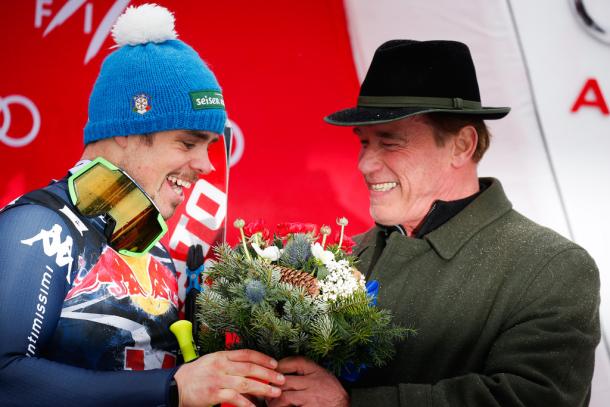
The Italian veteran Peter Fill had a brilliant start to his season, finishing second in the downhill and third in the super-G of Lake Louise. Downhill proved to be the more successful discipline this season when he returned back into the elite of speed skiers. In the Hahnenkamm downhill of Kitzbühel, he celebrated his career-second World Cup victory, over seven years from the first. As Svindal missed the second half of the season, Fill led the race to catch him in the lead of the downhill standings. Securing the title was not easy for him, finishing the last two races only in 10th places; he eventually beat Svindal by only 26 points. The discipline title was the first in Fill’s 15-year World Cup career, with his previous best having been fourth in the downhill standings in 2007.
Dominik Paris had a career-best season last winter when besides downhill he broke through in super-G, finishing second in the super-G standings. Paris’s 2015-16 season had a slow start and he made his first appearance on podium only in early February in the Jeongseon downhill. Yet that weekend started his great late-season run; in Chamonix he won the downhill and finished second in the alpine combined, and in Kvitfjell he won the downhill and finished second in the super-G. Thanks to those great results, he came into the final downhill only four points behind Svindal and Fill, yet failed to score points in the race after hurting himself in a training crash.
Beat Feuz And Carlo Janka The Swiss Winners
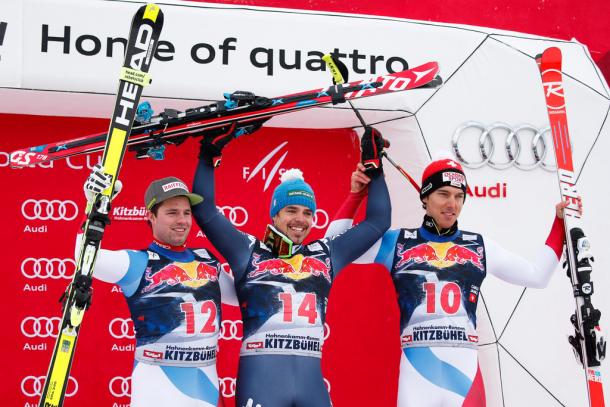
The 2010 overall World Cup champion Carlo Janka had suffered from health issues after his successful seasons around the turn of the decade. The 2014-15 season had marked his return to the winner’s step of the podium when he won the alpine combined in Wengen. Yet once again before this season, his body was causing problems; due to back issues, he couldn’t race in giant slalom until February, an important discipline if he wants to race again for the overall title.
Yet in the speed disciplines, Janka showed signs of returning back to top. In Jeongseon he achieved his first super-G race win on his way to a career-best fifth place in the super-G World Cup standings. In downhill he finished in 10th place of the standings. Excluding alpine combined, those were his first top-10 finishes in discipline standings after the 2010-11 season.
Beat Feuz is another Swiss with a career full of setbacks. The 2012 downhill and overall World Cup runner-up missed the 2012-13 season due to knee injuries. The 2013-14 season was mediocre from him but in the 2014-15 season he started finding his old good form, with the downhill World bronze medal and two second places in World Cup races as the season’s highlights.
The 29-year-old Swiss suffered yet another setback before this season. A partial right Achilles tendon tear kept him out until the Wengen races in January. Already in his second race weekend in Kitzbühel he climbed onto the podium when he was second in downhill. After that he made the podium again with the third places of Garmisch and Chamonix before completing the season with the downhill and super-G double win at the World Cup Finals of St. Moritz. Despite missing the first half of the season, Feuz ended the season in fifth place of the downhill World Cup, only 48 points from the champion Fill. In super-G Feuz’s final ranking was 12th.
Adrien Théaux The Top Frenchman
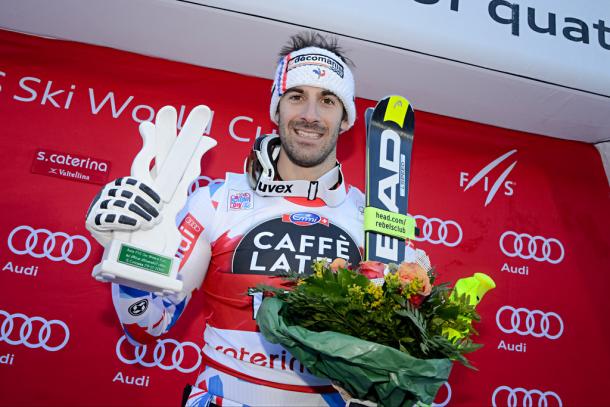
Adrien Théaux was the only French winner in men’s speed disciplines this season as he won the Santa Caterina downhill on an extremely rough slope in the end of December. Coming into the final race, Théaux was in fifth place of the downhill standings with a slim title chance. Yet a 16th place and missing the points in the final race of St. Moritz saw him falling into seventh place of the downhill World Cup, which was also his final ranking in super-G.
Guillermo Fayed was another regular frontrunner in downhill from the French team. Yet he suffered a torn ACL and an avulsion fracture in a training crash in Kvitfjell, forcing him out from the last two downhill races and the title contention.
The 24-year-old Valentin Giraud Moine had a positive end for his season. In the Kvitfjell downhill he achieved his career-first World Cup podium with a second place. He finished the season with his second top-10 finish in the St. Moritz downhill where he was seventh.
Yet another Frenchman who deserves a mention is Thomas Mermillod-Blondin. Competing mostly in speed disciplines, Mermillod-Blondin had a great campaign in alpine combined, finishing twice on podium and finishing in second place of the combined standings. He was also the only man to score points in both downhill and slalom this season as he made the top 30 in all races of the Wengen weekend.
Hirscher Only Austrian Winner In Men’s Speed
The Austrian team had an unsuccessful season in men’s speed disciplines. The 2014 downhill Olympic champion Matthias Mayer suffered season-ending thoracic vertebra fractures in the Val Gardena downhill in December.
Austria’s another speed star, the reigning super-G World Champion Hannes Reichelt also had a difficult season. The highlight of Reichelt’s season was the second place of the Wengen downhill where he lost to Aksel Lund Svindal only by 0.19 seconds, over a second ahead of the rest of the field. Yet like Svindal, also Reichelt suffered a heavy crash in the Kitzbühel downhill but was lucky to survive without a serious injury. Still, he couldn’t find his usual form after the Kitzbühel crash and finished in 10th place of the downhill and 13th place of the super-G World Cup, far behind previous season’s second place of the downhill and fourth place of the super-G standings.
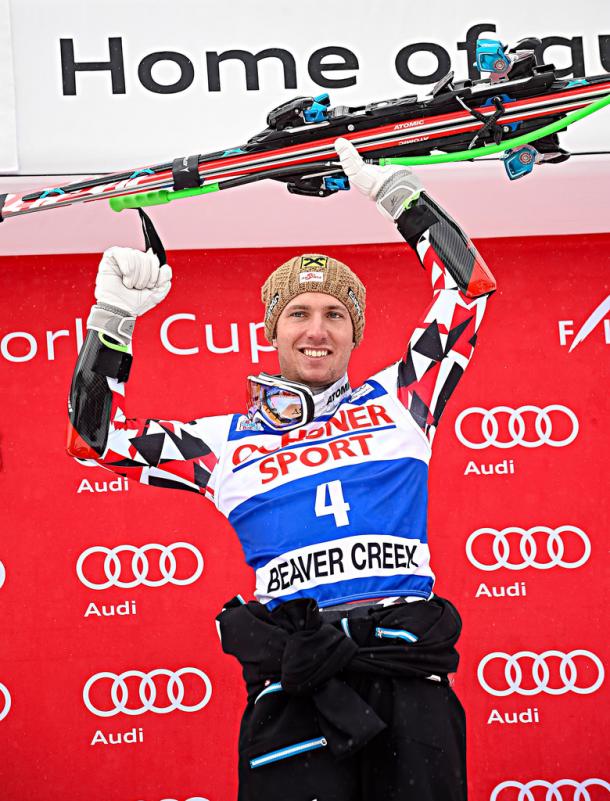
Surprisingly it was Marcel Hirscher who achieved Austria’s only speed-discipline win. Early starters like Hirscher were favored by weather conditions in the Beaver Creek super-G and the course setting was technical, allowing technical specialist Hirscher to achieve his first super-G win on the World Cup tour. His later performances, including a third place in Hinterstoder, however showed he was no one-race wonder in super-G.
Had Hirscher done the full schedule in super-G, he might even have been a title contender. After all, his average score per super-G start was higher than the runner-up Jansrud’s, though the super-Gs Hirscher didn’t participate would probably have been the most difficult ones for him. Also, the super-G performances played a big role in Hirscher’s overall campaign; not only they allowed him to pull away from Henrik Kristoffersen but they might have been enough to beat Svindal for the overall World Cup title. With average scoring from the races he missed, Svindal would’ve finished at 1659 points whereas Hirscher already now sits at 1670 points with two technical races remaining.
Vincent Kriechmayr was an Austrian who made his breakthrough this season. The 24-year-old made the podium twice in super-G and was a title contender until the final race; however failing to finish in St. Moritz saw him finishing in fourth place of the super-G World Cup standings.









































